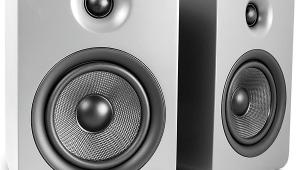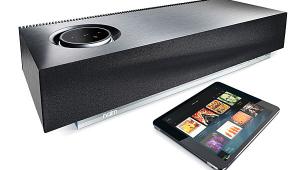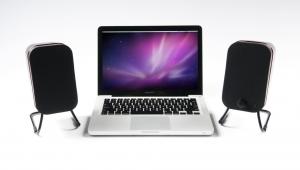Review: Blue Aura v30 Blackline Tube Desktop System

Vacuum tube electronics may be "obsolete," but like other enduring vintage technologies (think vinyl), those glowing glass cylinders still have a place in many an audiophile heart, and lately there's been something of a rennaissance in small, affordable tube products, with old school technology finding its way into everything from headphone amp kits to do-it-all docks from major CE firms. There's a tube solution, it seems, for almost everybody.
Blue Aura's v30 Blackline system ($549) is a little different, a luxury desktop system meant to evoke the sound, look, and feel of old-school gear, but designed by a young British firm with a focus on wireless and desktop products to serve a computer-audio savvy consumer. While the amp clearly looks back, through a warm glow, to a simpler era of audio componentry, it sports a USB input too, and it's companion speakers are conveniently sized to fit alongside a computer monitor.
Does it belong on your desk?
Setup
First thing you'll notice on unwrapping the v30 (aside from the bundled pair of white gloves and extra 6N1 tube, both handy for eventual maintenance tasks any tube gear will require), is the substantial heft of the little integrated amp. The meaty transformer's there on top for all the world to see; handle/tube protectors and a couple of stainless retainers keep the glass out of trouble and give the thing a dose of antique-Ampeg-meets-Metropolis retro appeal. A nicely tinned and soldered pair of plain vanilla speaker cables of the sort we tend to like around here let you set up cleanly, while a standard IEC power cord (no wall-wart here, of course) lets you plug in and means you'll have no trouble finding a replacement for the original cable should you misplace it.
For non-desktop applications, Blue Aura suggests mating the v30 with their own WSTxR wireless system, but obviously any wireless receiver would do since the connection's made using a good old analog input. So if you're looking for a base for a roll-your-own wireless speaker, you could do worse - just add one of the many Bluetooth units currently out there on the market, or an AirPort Express, or maybe a Sonos Connect - whatever floats your streaming boat.
Intelligently, the volume control on the front panel is a rotary encoder, so you won't run into situations where the setting on the remote is wildly out of whack with the on-device setting. It would have been nice to see more visual feedback of where the controls are set; there's a 6E2 meter tube dead center that gives you a rough visual idea of the output level, but some visual indication of where the tone controls - only accessible via the remote, by the way - are set would really help, especially in estimating a "flat" setting to begin your tweaking. Of course, front panel tone controls would be nice too; in a desktop situation the remote is a bit redundant, so I would have liked to have been able to dispense with it altogether.
Warming it up
Not only does the v30 look the part, it's an able performer. Does it sound like vintage gear? Generally, the design goals behind these hybrid tube designs aren't likely to include "accuracy" per se (sure, that's achievable, but these days more easily and cheaply executed with more contemporary approaches, but a bit of euphonic coloration. And the v30 doesn't disappoint on those grounds: it's got plenty of power for real-world applications (our guess is that those 6N1s are there for coloration; they aren't putting out 20 watts per side on their own), and the little guy sounds pretty darned good when cranked up.
I wouldn't call the v30 system a room filler, but it could certainly do double duty as a general listening system in a smaller space. Strain is evident if you really push it - things get soft-sounding and there's some evident distortion, as you might expect - but you probably won't be doing that in the near field anyway. But it's not meant to dish out the volume. At reasonable levels, the speakers have impressively good low-end definition. I put on some Lee Perry and I-Roy tracks, and while I wouldn't want to use these to animate a house party, I got plenty of kick at reasonable levels from bass workouts like "Hold on Death" (from Sensimilla Showdown), with plenty of detail to represent the spacey delay-and-percussion heavy top end.
For those not interested in active speakers (maybe you don't like the idea; maybe you have more sources than just your computer or phone and want more inputs), the Blue Aura v30 should make a very serviceable desktop system. A pair of analog inputs should be enough for most folks, and most importantly the little speakers sound very, very good in the near (and e ven mid) field; they're an ideal size for desktop placement and the dense rubber pucks position them at a nice angle to minimize interaction with your work surface. Stereo imaging is quite nice, and they've got a wide enough sweet spot that you won't need to remain statue-still at your desk to enjoy them.
The only real fault I noticed with the speakers was a touch of sizzle in the upper midrange, that didn't suit some vocalists. I noticed, for instance on Caetano Veloso's vocal on "Maria Bethania" (from his classic self-titled album), a touch of sibilance and overly present lip-smacking during the wordless improv at the close of the tune. This could be tamed with the treble control, but compensating enough to eliminate it alrogether rolled off the highs a bit much for my taste.
The weak link in this system, I think, is the digital input. The onboard USB DAC doesn't quite seem up to snuff given what's on the market these days at fairly low price points. I generally preferred using analog inputs in most of my listening, finding the usb input not to be a distinct improvement over the analog output of my MacBook Pro or AirPort Express.
For those concerned with such things, the v30's USB decoder is limited to 16-bit files, at either 44.1 or 48 kHz. Regardless of sample rate, when I switched over to digital sources I felt that hooking up via my workhorse Musical Fidelity V-DAC II or the more recent AudioQuest Dragonfly via the RCA analog aux input gave me better clarity, less graininess, and better overall instrumental definition - I found this particularly noticeable on heavier material (like the title track from Motorhead's Ace of Spades). You may already own a DAC you enjoy, so this may not be an issue (though you'll be giving up an analog input you might have put to other use), or you may not care about high-rez playback, in which case the USB input makes a convenient way to hook up a computer and nothing,more is asked. It's an area for potential improvement nonetheless. Maybe an optical input while we're at it, too, which would open up other common applications (set-top boxes, gaming systems, etcetera) where a small, high-performance audio system like this would be pretty welcome.
- Log in or register to post comments





























































